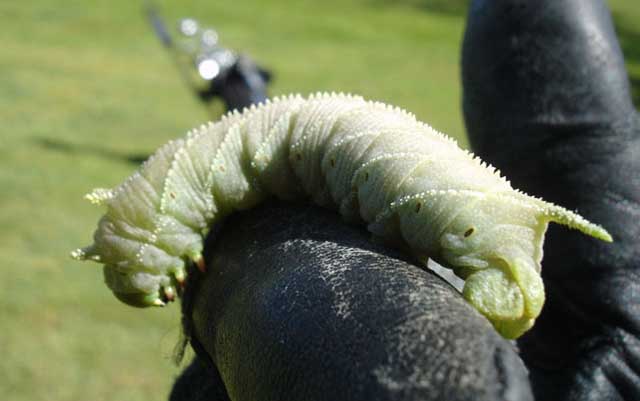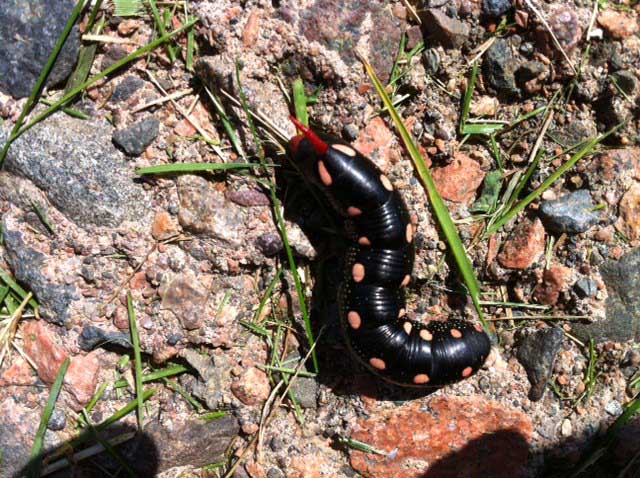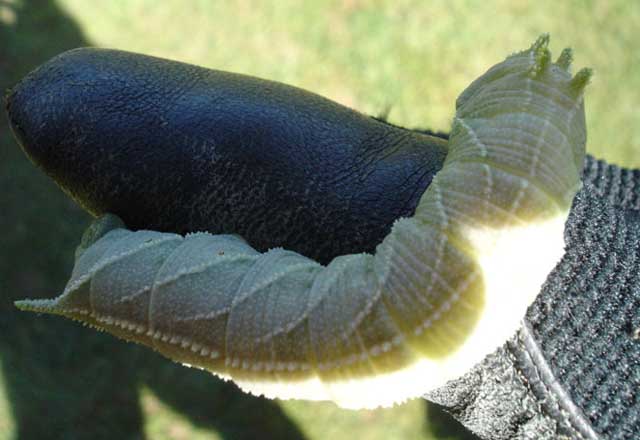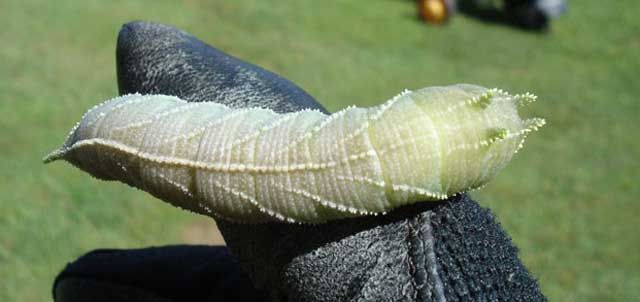New Brunswick, Canada
Sphingidae Larvae
Ceratomia amyntor fifth instar, Norton, New Brunswick,
Canada,
September 7, 2009,
courtesy of Gordon Snyder.

Ceratomia amyntor fifth instar, Norton, New Brunswick,
Canada,
September 7, 2009,
courtesy of Gordon Snyder.
Please help me develop this list with improved, documented accuracy by sending sightings (species, date, location), preferably with an electronic image, via email to Bill Oehlke.
This page is dedicated to Gordon Snyder in appreciation for his help with Sphingidae sightings and images in New Brunswick. Many thanks to other New Brunswick residents who have provided many images and much data.
Many thanks to Judy Caron who provides this beautiful imageof Hyles gallii.

Hyles gallii larva, Sackville, New Brunswick,
September 15, 2012, courtesy of Judy Caron.
Sphinginae subfamily
Smerinthini Tribe:
Macroglossinae subfamilyDilophonotini tribe:
See Hemaris comparison to help distinguish the next three species.
Macroglossini tribe:
Hyles gallii, Sackville, September 15, 2012, Judy Caron.
|

Ceratomia amyntor fifth instar, Norton, New Brunswick,
Canada,
September 7, 2009,
courtesy of Gordon Snyder.

Ceratomia amyntor fifth instar, Norton, New Brunswick,
Canada,
September 7, 2009,
courtesy of Gordon Snyder.
Enjoy some of nature's wonderments, giant silk moth cocoons. These cocoons are for sale winter and fall. Beautiful Saturniidae moths will emerge the following spring and summer. Read Actias luna rearing article. Additional online help available.
Eggs of many North American species are offered during the spring and summer. Occasionally summer Actias luna and summer Antheraea polyphemus cocoons are available. Shipping to US destinations is done from with in the US.
Use your browser "Back" button to return to the previous page.
This page is brought to you by Bill Oehlke and the WLSS. Pages are on space rented from Bizland. If you would like to become a "Patron of the Sphingidae Site", contact Bill.
Please send sightings/images to Bill. I will do my best to respond to requests for identification help.
 Show appreciation for this site by clicking on flashing butterfly to the left. The link will take you to a page with links to many insect sites. |
I very much appreciate all the many images that have been sent to me, or of which I have been granted permission to copy and post from other websites. All images on this site remain the property of respective photographers.
If you would like to contribute to the maintenace of this website by sending a contribution to
Bill Oehlke
Box 476
155 Peardon Road
Montague, Prince Edward Island, C0A1R0
Canada
your donation would be much appreciated and would be used for
1) paying for webspace rental;
2) paying for computer maintenance and software upgrades;
3) purchases of additional text reference material (journals and books) in anticipation of expanding the site to a worldwide Sphingidae site;
4) helping to pay my daughter's tuition; with anything left over going to humanitarian aid.
If you are mailing a check from USA, please use $0.85 postage. Donations can also be made through Paypal via the button below.